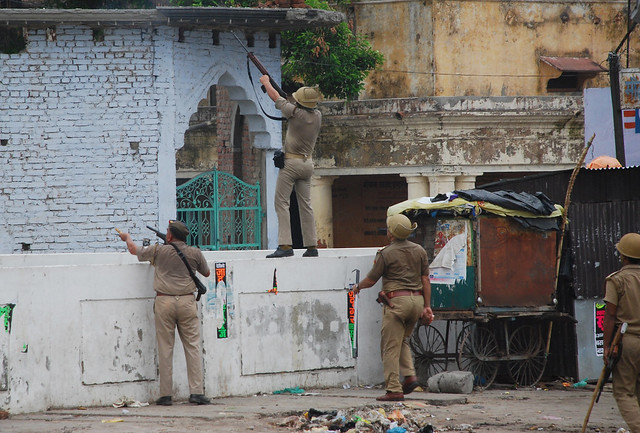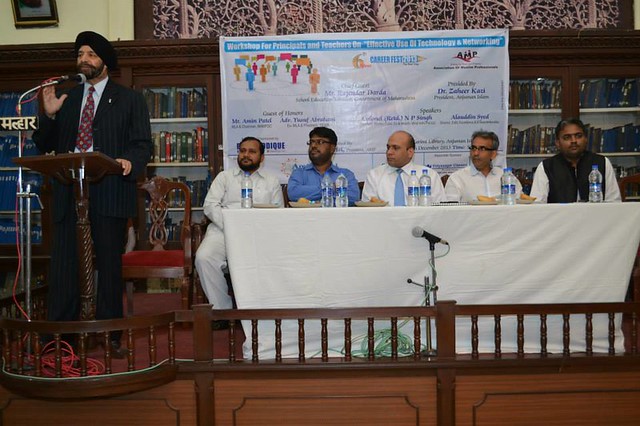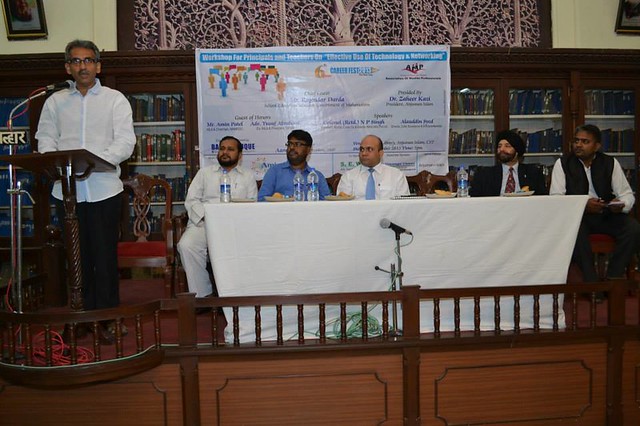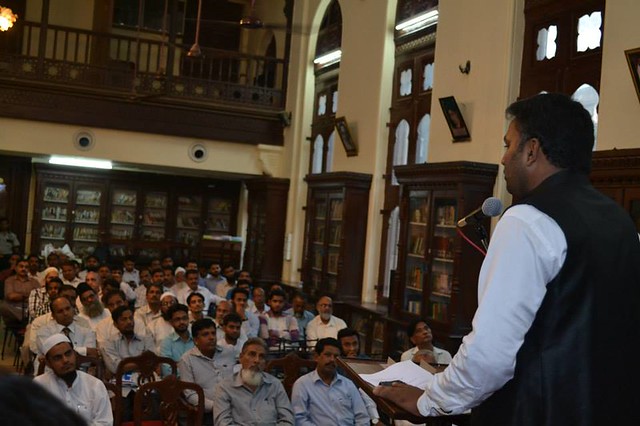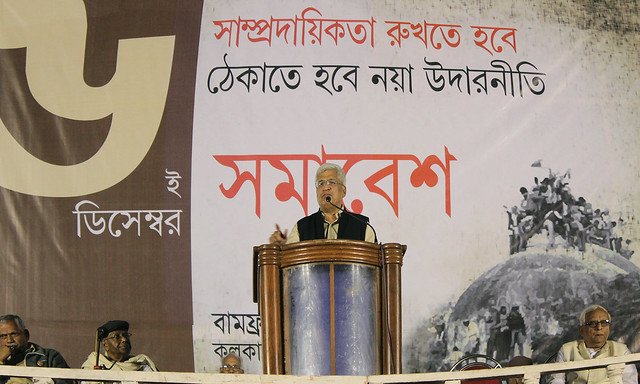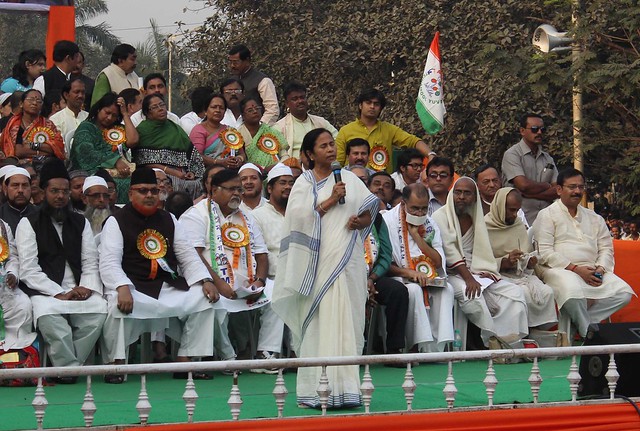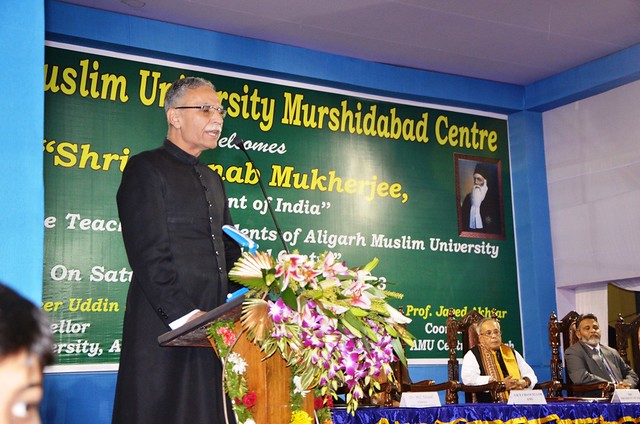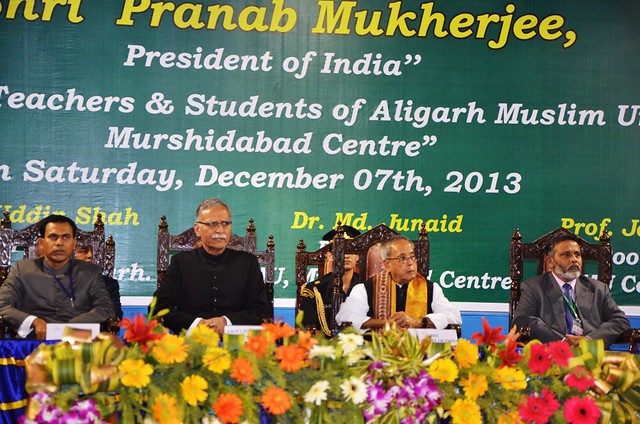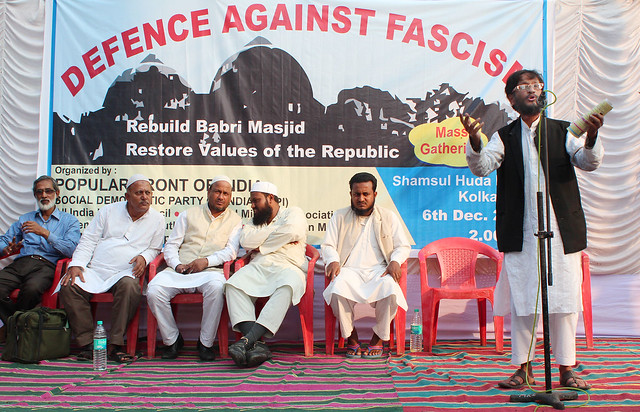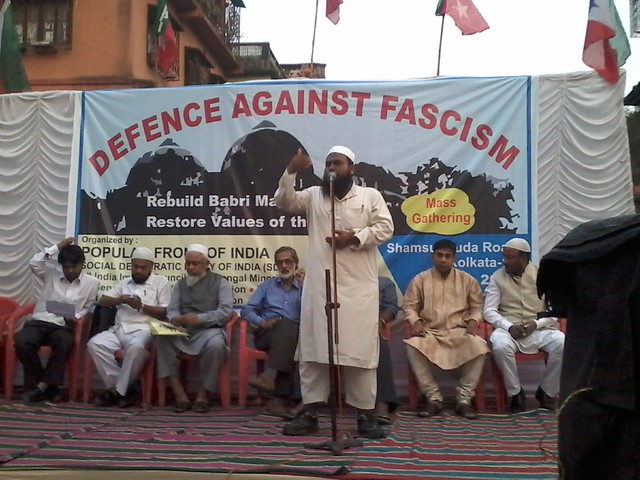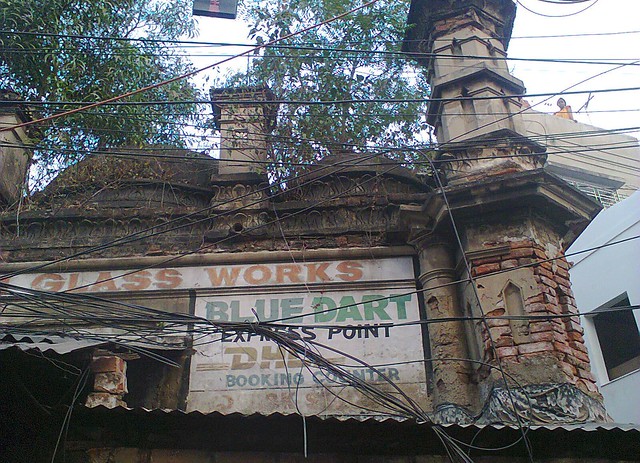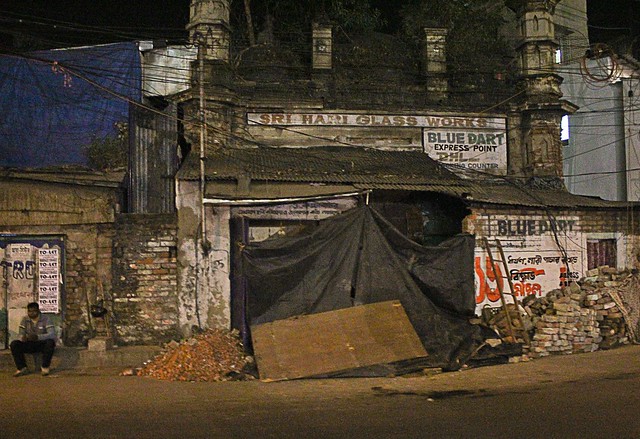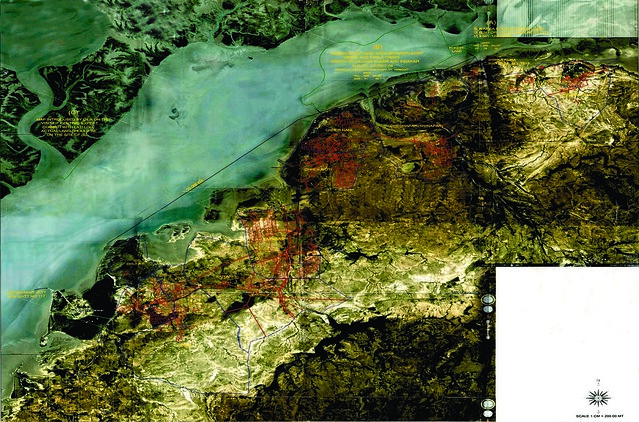By Irfan Engineer
Role of Police and administration in controlling communal violence has been wanting and in fact prejudicial to minorities. Communal riots in India are generally well planned. Riots that are spontaneous in nature can be controlled within 24 hours unless the police or the district administration or the government wants it otherwise. In other words, there are two necessary conditions for riots to continue beyond 24 hours – it should be well planned and the administration, including police, should want it to continue and should be otherwise complicit.
![]()
Police in Bareilly in 2012Vibhuti Narain Rai, an upright IPS officer with hands on experience in controlling riots and one who has studied communal riots and role of police extensively, argues that Indian society is not torn apart with civil war and existence of armed militias as in West Asia, Europe or other parts of the world. Therefore, if the police and administration is unable to control a riot a riot within 24 hours, it only means that their actions, conduct and behaviour need proper examination. Through his research, Rai has arrived at a conclusion that police and the administration have deep-rooted communal bias that prevents them from controlling communal violence within 24 hours. Dr. Asghar Ali Engineer also observed that during his investigations, constabulary in Mumbai were reading Samnaa, a daily news paper published by a communal party Shiv Sena. The constabulary which was deployed to control the communal riots in 1984 in Bhiwandi proudly proclaimed that they were Shiv Sainiks in uniform. In his investigation of Jabalpur riots in 1961, Engineer gives account of armed constabulary molesting Muslim women inside their homes and several accounts of police biases in his aforesaid article, though cautioning that there are unbiased and impartial police officers as well.
First stage: planning riots, exploiting issues to escalate tensions and early warnings of riots
Police are complicit at three stages. The first stage is that of early warnings when the riots are being planned. During this stage, religion wise data and their spatial distribution is being compiled. In Gujarat for example, the rioters attacked even those establishments and businesses having Hindu names, Hindu employees and Hindu partners. Even these establishments were not spared where, either one of the sleeping partners or the financers of the establishment was a Muslim. The data of Hindu establishments having Muslim partners was probably collected from sales tax authorities and registrars of partnership firms. Then Hindu and Muslim homes are marked for precise identification of the targets by the rioters. In Surat and Ahmedabad, Hindus were told to write “Jai Shri Ram on their houses”. During my investigation of Surat riots in 1992-1993, many of my informants told me that some individuals pretending to be from census authorities had come to check their ration cards and the data in the ration cards were noted by them.
Next, equipments to be used during riots are collected, like fuel oils and gas cylinders, to burn houses and weapons for stabbing. As an early warning, it is easy to observe escalating confrontation over practical non-issue/s between the two communities and mobilization of the communities through provocative speeches that promote enmity between two communities. If there were no riots in Bhiwandi and Aligarh, otherwise communal hotbeds, after demolition of Babri Masjid, it was because of effective and impartial preventive measures in the two towns. Every major riot has its early warnings spread over weeks and sometimes over months. L.K. Advani’s Rath Yatra before the demolition of the Babri Masjid is an example.
Kandhamal riots had their early warnings from 24thDecember 2008 when the arches erected by the Christians to celebrate Christmas was demolished by Sangh Parivar members and anti-Christian mobilization through provocative speeches were given, is another example. Police or the administration can pro-actively intervene during this stage, arresting those making provocative speeches or collecting equipments for riot or planning the riot, bringing together notables and ordinary members of both the communities together and facilitating interaction between them, undertaking confidence building and working out mechanism to counter rumours. If the administration is determined, outbreak of violence can be prevented at this stage. An early warning of a riot is fairly evident to any ordinary person of ordinary intelligence, let alone police, whose job is to gather intelligence. At this stage, the police are required to collect intelligence, take preventive actions like detention of anti-social and communal elements or execution of bonds, and instil fear in the minds of mischief mongers through show of force or diffusing tension through reconciliatory measures.
Often policemen’s attitudes towards abusive and objectionable slogans shouted during religious processions intended to be communally provocative and humiliate minorities is that of tolerance and inaction. They are not even perceived as objectionable or provocative and humiliating and they do not arrest or pull out such element from the procession nor take any action after the procession. In such cases the police report is that the procession was peaceful. During Bhiwandi riots in 1970, the unruly sections in the procession were obviously encouraged by the attitude of the police into believing that they had a licence to indulge in their misbehaviour and, therefore continued doing so with greater impunity (Madon, 1974, pp. 24, Vol. VI, Part VI). The Mohalla Committees are packed with the Hindu communal leaders as they are not perceived as communal. Provocative speeches routinely made by communal elements are not acted upon.
The second stage is when the communal violence has erupted. At this stage the police must use adequate coercive force like baton charge, teargas, or gunfire to disperse the rioters, enforce curfew or other prohibitive measures like prohibition against carrying of arms; protect victims of violence, comb areas where arms and ammunitions may have been stored and arrest the rioters. The third stage is that of investigation of riot related offences and bringing the culprits to the book.
The police and administrative impartiality is lacking at all the three stages. On account of their prejudices against minorities and at times due to instructions of political leaders in power, the administration fails to recognize early warnings of impending riot or ignores the early warnings and do not take any preventive measures (Sengupta, Kumar, & Gandeviya, 2003). Minorities are perceived by most police personnel as those who are likely to trigger off a riot and therefore preventive measures, if at all, target the minorities. At the height of Ram Janmabhoomi agitation led by right wing communal Hindutva zealots, it was very difficult to find the names of Hindu inciters in the list of communal elements maintained by the Ram Janambhoomi police station in Ayodhya writes V N Rai in his research paper. Police believe that to be communal is only prerogative of Muslims. Though demolition of Babri Masjid was a well planned conspiracy, none of the intelligence agencies reported the conspiracy before 6th December 1992, and the Liberhan Commission findings make this amply clear.
Second stage: maintaining law and order after outbreak of riots
In the second stage, often the police are helpless onlookers when the minorities are being targeted as in Surat Riots in December 1992 and January 1993. The police at times actively assist the rioters by misdirecting the gullible escaping members of minorities towards the rioters. When army handed the charge of about a hundred members of minorities to Bihar Military Police in Chanderi Village near Bhagalpur, The BMP on assurance of safe passage to the protected persons, allowed the rioters to butcher them. Police was in collaboration with the rioters, notes Dr. Asghar Ali Engineer in his article on “Communal Riots and the Role of the Police: Some Case Studies”, 1997. During the 1969 riots in Gujarat, a number of religious places belonging to the Muslim community and located near the police stations were deliberately allowed to be damaged, concludes the Jaganmohan Reddy Inquiry Commission its report. It also concludes that the policemen have been affected by the same communal virus as they are a part of the society.
Though minorities suffer much more (on an average, about 80 percent victims of riot are from minority community), they are the targets of police firing and arrests during riots and are victims of arrests made by police during riots. This fact has been brought out by Justice Srikrishna Commission, 1998, V N Rai’s research, and my own investigations of Surat Riots, besides other fact finding reports. In most of riots where the number of Muslims killed was many times more than Hindus, it was they who were mainly arrested, curfew imposed strictly in their localities and their houses were subjected to brutal searches and combing operations. In the riots in Surat, even when huge mobs were on streets, curfew was not enforced by the police. Many lives could have been saved had the curfew been enforced. The lone individuals who were travelling to search for their near and dear ones in hospitals were being penalized for violations of curfew. V N Rai gives examples of such operations in Ahmedabad in 1969, Bhiwandi (1970) and Bhagalpur (1989).
Muslim localities are cordoned off during riots with the help of the army or para military forces and then all the houses are searched indiscriminately debauching the pride of the entire community. While curfew is strictly enforced in Muslim localities, in Hindu areas, curfew is virtually confined to main roads while normal life continues in the lanes and by lanes. While none of the Hindus were killed in police firing in Bhiwandi (1970), Ferozabad (1972), Aligarh (1978) and Meerut (1982), 9, 6, 7 and 6 Muslims were killed in police firing in these towns. During communal riots in the first phase in Bombay in December 1992, most of the Muslims were killed in police firing. Out of 250 deaths during this phase, 192 died in police firing and out of those, more than 90 percent had sustained injuries above abdomen proving that police fired to kill and not to disperse a rioting mob. Police dragged men out of their houses in Govandi during riots in Bombay in 1992 December and January 1993 and shot them dead. The inspector responsible for shooting was merely transferred. Govandi saw the worst atrocities of the December riots in Bombay during the combing operations from December 7 to 10. There were no communal tensions in Govandi, yet police had visited lane after lane, broke into houses, looted them, arrested innocent Muslims, beat them and in some cases shot them dead. Hindus of the area were deeply agitated at the police atrocities on their Muslim neighbours, with whom they had been living for years in peace (Fact Finding Report of the Committee for the Protection of Democtratic Rights & Lokshahi Hakk Sanghatana, 1993).
During the Gujarat carnage in 2002, despite the fact that the minority community was being attacked by massive, well-armed mobs, Muslims seem to have been the target of police firing. Of the forty persons killed in police firing at Morarji Chowk and Charodia Chowk in Ahmedabad on 28 February, all were Muslims and according to figures provided by Gujarat police and reported by Vinay Menon of Hindustan Times on 3rd May 2002, of the 184 persons who died in police firing since the violence began, 104 were Muslims. The Police in Gujarat was actually helping the rioters attain their objective far effectively with their equipments. This happens because, like an average Hindu, the policemen also have biases against the minorities and Muslims to be of cruel and violent nature. They further believe that riots can only be controlled by teaching a lesson to Muslims who started the riots in the first place. Whenever government instructs to deal with the rioters firmly, the message is understood and interpreted to mean dealing firmly with Muslims. This prejudice leads the police to gather facts selectively to prove what they believe. V N Rai recalls his discussions with the policemen in Bhagalpur and Bombay who continued to believe that Hindus were naturally non-violent and pious in spite of pointing out that the damage caused to Muslim was far more than that caused to the Hindus.
Dr. Asghar Ali Engineer in his investigation of Bhiwandi riots in 1984 found that the State Reserve Police on duty without any exception were taking shelter in Shiv Sena Shakhas. They were naturally not expected to take shelter or seek shade near Muslim homes as they would feel insecure on account of their belief that Muslims were cruel. Sitting outside Shiv Sena Shakhas, they were bound to be influenced by their perceptions and views and see Muslims as the culprits. During the riots in Bhiwandi and Jalgaon in 1970, one Muslim lady alleged that her son was shot dead inside her house by a sub-Inspector of Jalgaon police station (quoted by Dr. Asghar Ali Engineer in his book “Communal Riots and the Role of the Police: Some Case Studies”, p. 249).
Farooq Mapkar from Mumbai has registered a case with the police that during riots in Mumbai, in the month of January 1993, police entered Hari Masjid in Wadala and opened unprovoked and indiscriminate firing on unarmed people. Seven persons were killed and many others injured. Farooq, a bank employee was one of the 54 persons who were picked up and falsely charged with rioting and attempt to murder. Mapkar was honourably acquitted from the charge after a sixteen years’ fight. Mapkar was rather a victim of the unprovoked firing and was injured on his shoulder. Mapkar is now fighting for justice to get a CBI inquiry against the person who fired on him – PSI Nikhil Kapse.
Jt. Commissioner of Mumbai Police Mr. R.D. Tyagi led a team of policemen inside Suleiman Bakery and killed nine innocent persons inside the bakery without any provocation during Mumbai riots in December 1992-January 1993. During riots in Meerut (in the year 1987), Provisional Armed Constabulary picked up more than two dozen Muslim youth from a locality called Hashimpura on 22nd May and killed them in two places in Ghaziabad, after transporting them in one of their trucks. Rai was SP of Ghaziabad at the relevant time and got two offences registered against the PAC personnel. They killed the Muslim youth only in the belief that unless the Muslims are taught lesson, the riots will not stop, that Meerut had become mini-Pakistan because of Muslim stubbornness. The relations between Muslims and police becomes antagonistic with incidents like Hashimpura, combing operations, excessive and unwarranted use of force discrimination in implementation of curfew and such behaviour leads to these growing distrust and inimical relations between Muslims and police force which in turn leads to some Muslim youth at times attacking the police as, for example, after Babri Masjid demolition in Mumbai.
In Gujarat 2002 carnage, the police did not respond to the telephone calls from the minority community members and did not allow members of minority community to take shelter in police stations and allowed those involved in looting and arson to carry on unhindered. Gujarat police misguided the victims who managed to escape the rioters about the escape routes and directing them towards the perpetrators of violence making them easy preys. In certain areas, police supplied fuel from their official vehicles to the arsonists to burn the homes of the minorities after they were looted. It was reported to the TISS team that in Baroda a truck load of people armed with swords and trishuls could pass by a police patrol van with police advising them to complete their tasks within an hour and they would reach they spot only after that. Muslim women taking shelter in one of the houses were molested by a police sub-inspector and his men. The Gujarat police did not protect even a High Court Judge with Muslim name, an IPS officer and Colonel in the Army with Muslim name. The officers who took effective measures to prevent or control riots were transferred to administrative posts. Muslims members of the police force were forced to take leave or engaged in office maintenance work In fact, politicians were allowed to sit in the control room and direct all operations.
In Chamanpura and Naroda, police were mere bystanders watching the mob attack Muslims. Though the Muslims were victims and Hindu communal organizations like VHP and Bajrang Dal were aggressors, in the 2002 Gujarat carnage, the combing operation were almost exclusively carried out in Muslim areas. Police acted with great brutality, beating and seriously injuring Muslims causing them multiple fractures and destroying their property. They were arbitrarily arrested and falsely implicated under S. 307 of IPC (attempt to murder). Most of the brunt during “combing operation”, including sexual indecencies and sexualized abuses and merciless beatings was taken on by Muslim women, as men would go into hiding to avoid arrests. Pregnant women were specially targeted for brutal beatings and told let the foetus die before it is born. Out of 1,300 incidents of violence or attempted violence in the city of Vadodra till mid-May, PUCL-Vadodra and Shanti Abhiyan had information that in 814 incidents, police remained absent, in another 397 incidents, police was informed but inactive, in 60 incidents, there was no response from police, in 25 incidents, police was present and actively involved and only in 27 incidents, police prevented them.
Rai finds investigating agencies full of communal bias. UP C.I.D. took eight years to complete investigation of a case of unparalleled savagery in Hashimpura during Meerut riots in 1987 wherein PAC had shot more than two dozen Muslim youth after loading them onto their truck. In the third stage, either the FIRs are not recorded or require much persuasion and efforts on the part of the victims, particularly from the minority community to get their FIRs registered, and if registered, the police in most cases deliberately omit to note down the names of the offenders identified by the victims or distort the FIRs intentionally in other material particulars. During Bhagalpur riots that started on 24th October 1989, 116 Muslims were killed in Logain village on 27th October 1989, their bodies buried in agricultural fields and cauliflower was cultivated. The 65 survivors of the incident ran from pillar to post to get an FIR registered and though the incident was reported in local and national dailies, the police kept denying the incident till 8th of December 1989 when the fields were dug and the bodies were found by DIG Mr. Ajit Dutta. The cases filed later led to convictions of some of the accused. Justice D. P. Madon Commission appointed to report on the Bhiwandi-Jalgaon Riots in 1970 found many instances of police not reporting incidents in which Hindus were involved due to their bias and completely inventing conspiracy of Muslims in Bhiwandi riots.
No serious efforts are made to investigate the offences and files are closed under A summary or B summary proceedings (i.e. incident found true but cannot be investigated any further or incident reported false) and a very few that do reach the stage of trial rarely result in acquitals due to the disinterest in proper prosecution of the cases on account of communal bias. Reporting of facts and gathering of intelligence to be sent to the government and senior police formations are coloured by the bias and prejudice and the terms Muslims and communal in the eyes of policemen become synonymous. L.B.S. National Academy of Administration, Mussourie analyzed 189 FIRs filed in the month of September during communal violence in Meerut in 1982. 18 of these FIRs pertained to offence of Murder u/s 302 and/or attempt to murder u/s 307 and were broadly divided into two – one group in which Muslims were aggressive and other group in which Hindus were aggressive. In the FIRs which were against Muslims aggression, two Hindus had been killed. In that FIR, 232 Muslims and 23 Hindus had been arrested. While in the case of FIRs that were against Hindu aggression, seven Muslims had been killed but no arrests whatsoever had been made. The Muslim prisoners arrested are often beaten up with the connivance of the police or jail. Six Muslims arrested after the 1987 Meerut riots were killed in Fatehgarh Jail when officials of jail and other prisoners attacked them. While the Muslims accused of terrorist attacks are being produced in courts, they are often attacked inside the court premises.
During the 2002 carnage in Gujarat, some police officers were actively assisting the rioters by giving them oil from their vehicle to set fire to Muslims properties and firing on Muslims to assist the rioters to do the rest of the job of looting and burning their properties. The police were “overactive” in allowing perpetrators to act freely, thus acting as agents of negative control. In one of the affected villages during Gujarat carnage in 2002, the rioters desecrated a madrasa and placed an idol of Hanuman. According to the villagers, some police officers who came after the incident were happy that Lord Hanuman established himself there. Justice Srikrishna Commission reports interception of a wireless message between the policeman manning the control room and policeman from the field. The policeman from the field required that a fire brigade be sent to douse the fire. Instead of taking prompt action, the control room inquired whether the property set afire belonged to a Muslim or a Hindu. The failure of police and criminal justice system in bringing the offenders and rioters, particularly those who plan, conspire, abet and execute riots, to book, has allowed what Paul Brass calls as Institutionalized System of Riot production to grow in numbers and in their expertise and capabilities to inflict much higher casualties in shorter duration. We all saw in Gujarat in 2002 the lethal capability of this Institutional System of Riot production and what they could deliver in 72 hours they had before the State Government would have to deploy army. Likewise we were also witness to the destructive and lethal capability of the IRS in Kandhamal in 2008 and 2009.
The main findings of study of Vibhuti Narain Rai on neutrality of Police was as follows:
(a) “Police behave partially during most riots. In all the riots discussed in this study they did not act as a neutral law enforcement agency but more as a “Hindu” force.
(b) Perceptible discrimination was visible in the use of force[,] preventive arrests[,] enforcement of curfew, treatment of detained persons at police stations, reporting of facts and investigation, detection and prosecution of cases registered during riots. Muslims suffered in all the above mentioned areas.
(c) The perception by Hindus and Muslims of the police during communal strife is diametrically opposed. Hindus view policemen as their friends and protectors during communal riots. Muslims, by and large consider policemen their enemies in similar situations.
(d) An average policeman does not shed his prejudices and predetermined beliefs at the time of his entry into the force, and this is reflected in his bias against Muslims during communal violence.
(e) The expectations of the Indian society from an average policeman is communal. The policeman is believed to be a protector of the interests of his community.
(f) The inimical relationship between the police and the Muslims make them over react in a confrontation like situation”.
There is complete polarization of perception about the police in India along communal lines. While 97% of riot victims from Muslim community saw police as their enemies according to Rai’s survey and 73.5% of minority victims said they would not approach the police for help during communal riots, only 6.5% of riot victims from majority community saw police as enemies and 93% of riot victims from majority community said they would approach police for help during riots.
It may be interesting to note that though paramilitary and military forces also more or less share same religious composition as that of police, their record in maintaining neutrality and impartiality during riots is far better than the police. Rai’s survey shows that 51% and 37% of members of minorities reported during the survey that they would prefer CRPF and Army respectively and only 6% and 18 percent reported their preference for PAC and Civil Police. While the members from majority community during the survey largely preferred the PAC (51.5%) and Civil Police (35%) and only 10% and 8.5 % preferred CRPF and Army respectively. My own investigation of riots has shown that Army and CRPF have made best efforts to control the riots impartially and rarely acted on the basis of the religion of the victims or the perpetrators of riots. Bias and prejudice among the policemen is not located in their religious affiliation alone. Religious affiliation may be necessary but not sufficient condition for them to allow their prejudices free play in guiding their policing action. The remoter the location from which the force has been mobilized, the lesser their familiarity with the issues that were used for religio-communal mobilization and lesser their exposure to the media coverage of the issue. Police force mobilized from outside the state do not share the sense of injustice and strain created around the issue in dispute that triggered off the riots, as the media they are exposed to may not have covered with the same bias. Individual policemen from out of state police force may also not enjoy the same degree of assurance and confidence in their immunity from prosecution if they do not act impartially as the local police force do.
The fear of being made accountable weighs very much even on the policeman nurturing worst bias. The intensity of identification with the rioters from the majority community on the streets is much less due to all these factors. The central forces, para military and the army are also less amenable to the influence of the local politicians and district administration as they do not control their postings and promotions. The sooner they effectively control the riots, the earlier they return to their home state. The collective strain experienced by the members of the central forces, paramilitary forces and army posted during the riots on the one hand and the sense of comradeship or spirit-de-corps which develops between them on account of their living, dining, playing together and sharing the same duties comes into play and the “we” and “they” relationship develops between the force and the rioters, to whichever community they may belong. Finally, a sense of satisfaction of duty well performed when they are able to rescue the victims and experience their gratitude. The sense of righteousness and impartiality is not absent in the local police force. We find many policemen even from the local police forces who save lives, act impartially but are fewer and marginalized within their respective forces. R.B. Sreekumar, of Gujarat police risked his interests and career to stand up for righteousness during the 2002 carnage. Long term engagement of central police forces, paramilitary forces or even the Army in a particular area leads these forces to imbibe and act according to their prejudices against the minorities and their interventions stop being strictly professional. The deployment of Army in Kashmir and North East is a case in point.
Conclusion
Communal bias of police is reflected in everyday policing. It leads to communal profiling of minorities, particularly the Muslims. There is ample evidence of communal profiling in the above article and also in everyday policing, whether it be staged encounters or arrest of large numbers of innocent young male Muslims after every bomb blast and indeed higher number of Muslim under trials (28% in Maharashtra though they constitute 10% of the state’s population) and lower rate of conviction by courts (17% as against 22% rate of conviction for others). The bias has to be dealt with through induction training as well as mid career trainings. Recruiting appropriate number of members of minorities in the force is another mechanism through which the force can partly over come anti-minority biases.
However, even more important is instituting legal mechanisms to make the force strictly accountable for their commissions and omissions whenever they are in violation of law. If law provides legal remedies to victims of arbitrary actions of members of police force that violate their human rights and the procedures are victim friendly, quick and effective that will go a long way in ensuring policing that relies less on arbitrary discretions of police personnel and more on standard operation procedures that are fair and free from bias. Command Chain responsibility of higher officers will also ensure better and more accountable supervision of the force.
The Independent Police Complaints Commission (IPCC) is a non-departmental public body in England and Wales responsible for overseeing the system for handling complaints made against police forces in England and Wales. India too could learn from that. Members of the Commission are prominent citizens with powers to investigate complaints against any officer who may have violated human rights or acted arbitrarily.
Communal and Targeted Violence Bill is another proposed legislation that can partly address the problem by making the police accountable for their omissions and commissions. The draft of legislation provides a remedy to make police officers accountable as victims can file complaints against police officers. The proposed draft legislation also operates on the doctrine of command chain responsibility holding superior officials responsible and liable for illegal acts and omissions of those working under their command and control.
-----
Irfan Engineer is associated with Centre for Study of Society and Secularism, Mumbai.


